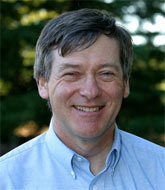

Monday - March 15, 2010
SLAC Today is
available online at:
http://today.slac.stanford.edu
In this issue:
Seeking Dark Matter on a Desktop
Fermi Telescope Spotted over Hawaii
Are Enchantment and Science Compatible?
Colloquium Today: Saturn and its Rings: Results from Cassini
 |
 |
|
Monday - March 15, 2010 |
Seeking Dark Matter on a DesktopShoucheng Zhang of the Stanford Institute for Materials and Energy Science.
(Photo courtesy Brad Plummer.)
Desktop experiments could point the way to dark matter discovery, complementing grand astronomical searches and deep underground observations. According to recent theoretical results, small blocks of matter on a tabletop could reveal elusive properties of the as-yet-unidentified dark matter particles that make up a quarter of the universe, potentially making future large-scale searches easier. This finding was announced today by theorists from the Stanford Institute for Materials and Energy Science, a joint institute of the Department of Energy’s SLAC National Accelerator Laboratory and Stanford University, at the American Physical Society meeting in Portland, Oregon. "Tabletop experiments can be extremely illuminating," said condensed matter theorist Shoucheng Zhang, who published the results with SIMES colleagues Rundong Li, Jing Wang and Xiao-Liang Qi. "We can make observations in tabletop experiments that help us figure the deeper mysteries of the universe." In a paper published in the March 7 online edition of Nature Physics, Zhang and his colleagues describe an experimental set-up that could detect for the first time the axion, a theoretical tiny, lightweight particle conjectured to permeate the universe. With its very small mass and lack of electric charge, the axion is a candidate for the mysterious dark matter particle. Yet, despite much effort, the axion has never been observed experimentally. Read more... Fermi Telescope Spotted over HawaiiRichard Dubois presents his poster and shows off
his Hawiian shirt—the conference handed them out to all participants—at the 2010 HEAD meeting in
Hawaii. (Image courtesy Richard Dubois.)
I had just stopped on the very dark sidewalk on the two-mile trek from a local eatery to my hotel at the 2010 High Energy Astrophysics Division meeting inin Waikoloa, Hawaii, when my colleague on the Fermi Gamma-ray Space Telescope, Luis Reyes from the Kavli Institute in Chicago, almost literally ran into me. And asked if I was looking for Fermi. I had sent mail to the Fermi attendees asking whether any would be searching the skies for it. Our colleague Tom Glanzman, left behind at SLAC, had been asking if we'd seen it down here, and sure enough, we found it after just a few minutes. It was on what's called the 19:40 pass , with 37 degrees maximum elevation above the horizon, a faint dot moving from west to east. I have to give Luis credit for the discovery—His experience with the VERITAS observatory helped him guess where 37 degrees elevation is, and his eye caught the faint movement. But I did confirm immediately! I think the telescope might have soon gone into eclipse, as we lost it when a car went by and did not pick it up again. (Admittedly we did not try hard, since we'd already had success!) We think we might be the only Fermi folks yet to see it in orbit.  Roger Blandford.
(Photo by Christine Aguilar.) Are Enchantment and Science Compatible?Is there meaning in our increasingly rational and secular world? Is science motivated by wonder or by cold logic? Joshua Landy, Stanford associate professor of French, and Roger Blandford, professor of physics and director of the Kavli Institute for Particle Astrophysics and Cosmology, offer their perspectives In the latest installment of the Thinking Twice Forum. Colloquium Today:
|
Events
Access (see all)
Announcements
|
|
| | ||
|
|
||
 <%
Response.AddHeader "Last-modified", getArticleDate()
'Response.AddHeader "Last-modified","Mon, 01 Sep 1997 01:03:33 GMT"
'Monday, December 06, 2010
%>
<%
Response.AddHeader "Last-modified", getArticleDate()
'Response.AddHeader "Last-modified","Mon, 01 Sep 1997 01:03:33 GMT"
'Monday, December 06, 2010
%>View online at http://today.slac.stanford.edu/. |
||